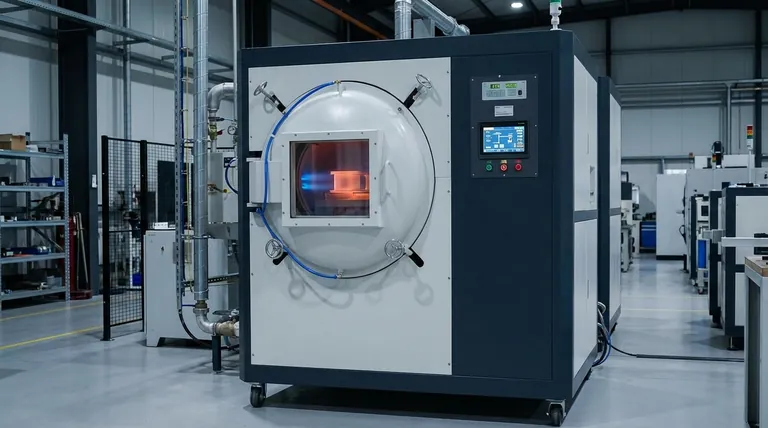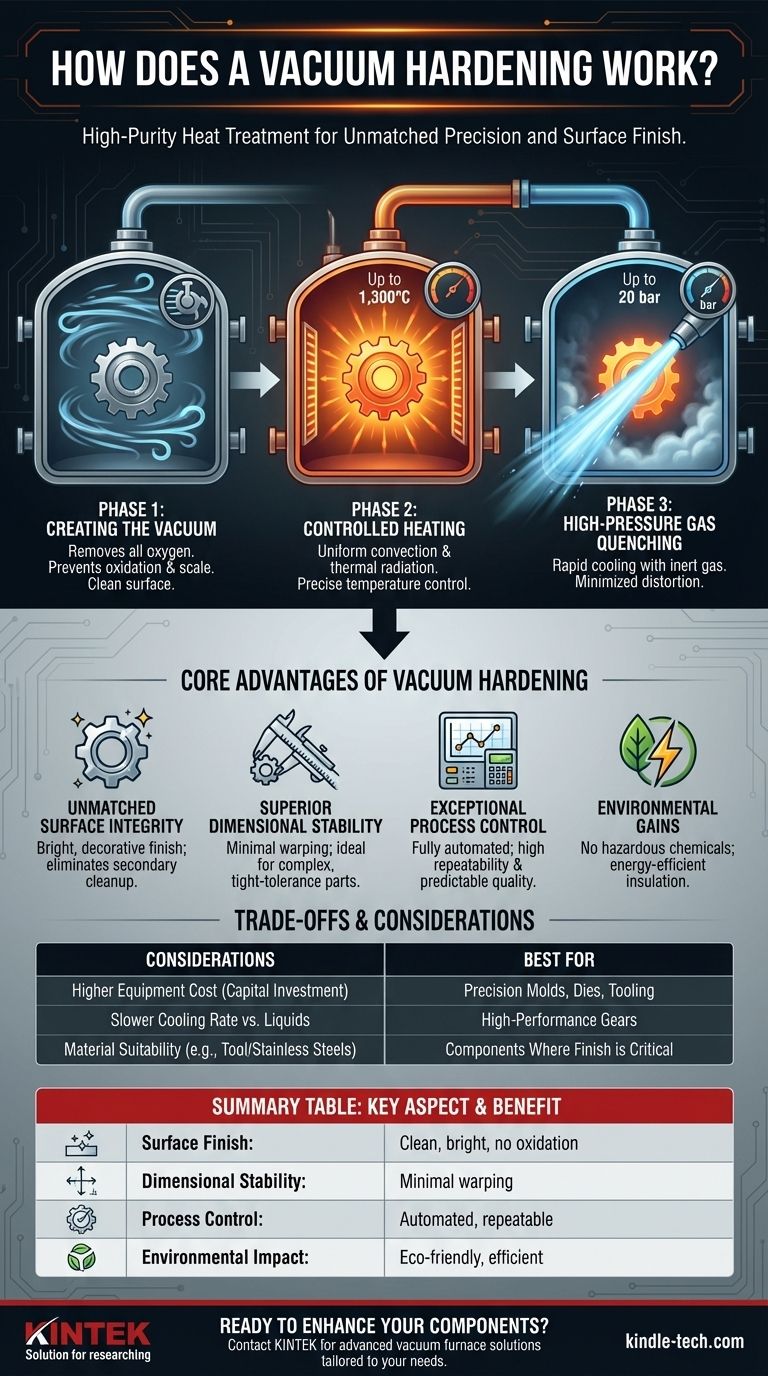At its core, vacuum hardening is a high-purity heat treatment process. It involves heating a metal component to a critical temperature inside a vacuum chamber, which removes all oxygen. The component is then rapidly cooled, or "quenched," using a controlled high-pressure stream of inert gas, typically nitrogen, to achieve the desired hardness.
The true purpose of vacuum hardening isn't just to make steel hard; it's to do so with exceptional precision and without damaging the part's surface. This method eliminates oxidation, ensuring a clean, bright finish that often requires no further mechanical processing.

The Vacuum Hardening Process, Step-by-Step
To understand why this method is so effective, it's helpful to break down the key phases of the operation. Each step is meticulously controlled to achieve a specific metallurgical outcome.
Phase 1: Creating the Vacuum
The process begins by placing the components inside a sealed furnace and pumping out the air. This removal of oxygen is the most critical step.
By creating a vacuum, the process prevents the formation of scale and other surface oxides that plague conventional heat treatment methods. It also prevents surface decarburization, a weakening of the steel's surface layer.
Phase 2: Controlled Heating
Once under vacuum, the components are heated. This is accomplished through a combination of convection using an inert gas and thermal radiation from the furnace's heating elements.
Temperatures can reach up to 1,300°C, and modern systems use sophisticated computer controls to ensure the heating is uniform and precise. This level of control is essential for consistent results.
Phase 3: High-Pressure Gas Quenching
After soaking at the target temperature, the component must be cooled rapidly. In vacuum hardening, this is achieved by flooding the chamber with a high-pressure inert gas like nitrogen.
The cooling rate is precisely managed by adjusting the gas pressure, often up to 20 bar. The direction and timing of the gas flow can be customized based on the component's geometry to minimize distortion.
Why Choose Vacuum Hardening? The Core Advantages
The decision to use vacuum hardening is driven by its unique benefits, which go far beyond simple hardness to deliver a higher-quality final product.
Unmatched Surface Integrity
The most significant advantage is a perfectly clean, bright, and "decorative" surface finish. Because no oxidation occurs, the parts emerge from the furnace ready for use, eliminating the need for costly and time-consuming secondary operations like sandblasting or grinding.
Superior Dimensional Stability
The highly controlled and uniform heating and cooling cycles minimize warping and dimensional changes. This makes vacuum hardening the ideal choice for complex parts with tight geometric tolerances, such as injection molds and precision tooling.
Exceptional Process Control and Repeatability
Modern vacuum furnaces are fully automated and computer-controlled. This guarantees that every part in a batch, and every subsequent batch, receives the exact same treatment, leading to extremely high repeatability and predictable quality.
Environmental and Efficiency Gains
Vacuum hardening is an environmentally friendly process. It uses no hazardous chemicals and consumes less energy than older furnace technologies due to superior insulation.
Understanding the Trade-offs and Considerations
While powerful, vacuum hardening is not the solution for every application. Its precision and quality come with specific considerations.
Equipment and Initial Cost
Vacuum furnaces are complex, specialized pieces of equipment that represent a significant capital investment. This generally translates to a higher per-piece cost compared to conventional atmosphere hardening.
Slower Cooling Rates vs. Liquids
Gas quenching is highly controllable but is inherently slower than quenching in oil or water. For some low-alloy steels that require an extremely rapid quench to achieve maximum hardness, gas quenching may not be sufficient.
Suitability for Material and Part Geometry
The process is best suited for air-hardening tool steels and certain stainless steels. The effectiveness of the gas quench can also be limited by the mass and cross-sectional thickness of the component being treated.
Making the Right Choice for Your Application
Selecting the right hardening process depends entirely on your project's priorities.
- If your primary focus is precision and surface finish: Vacuum hardening is the superior choice for components like dies, molds, and high-performance gears where dimensional accuracy and a clean surface are non-negotiable.
- If your primary focus is high-volume, low-cost production: For simpler components made from common alloys where surface finish is less critical, traditional atmosphere or salt bath hardening may be more economical.
- If your primary focus is minimizing post-treatment processing: Vacuum hardening provides a near-net-shape result, drastically reducing or eliminating the need for costly secondary cleanup operations.
Ultimately, choosing vacuum hardening is an investment in precision, quality, and process control for components where failure is not an option.
Summary Table:
| Key Aspect | Benefit in Vacuum Hardening |
|---|---|
| Surface Finish | Clean, bright, decorative finish; no oxidation or decarburization |
| Dimensional Stability | Minimal warping and distortion; ideal for complex, tight-tolerance parts |
| Process Control | Fully automated, computer-controlled for high repeatability and quality |
| Environmental Impact | No hazardous chemicals; energy-efficient due to superior insulation |
Ready to enhance your precision metal components with vacuum hardening? At KINTEK, we specialize in advanced lab equipment and consumables, including high-performance vacuum furnaces tailored for demanding laboratory and industrial applications. Our solutions ensure unmatched surface integrity, dimensional stability, and process control for critical parts like molds, dies, and tooling. Contact us today to discuss how our vacuum hardening expertise can optimize your results and reduce post-processing costs!
Visual Guide

Related Products
- Vacuum Heat Treat Furnace with Ceramic Fiber Liner
- Vacuum Heat Treat Furnace and Levitation Induction Melting Furnace
- Vacuum Heat Treat Sintering Brazing Furnace
- Molybdenum Vacuum Heat Treat Furnace
- 2200 ℃ Tungsten Vacuum Heat Treat and Sintering Furnace
People Also Ask
- Why do you vacuum for heat treatment? Achieve Flawless, High-Performance Metal Components
- What materials are used in a vacuum furnace? A Guide to Hot Zone Materials and Processed Metals
- What materials are used in a vacuum furnace? Selecting the Right Hot Zone for Your Process
- What are the advantages of a vacuum furnace? Achieve Superior Purity and Control in Heat Treatment
- What is the leak rate for a vacuum furnace? Ensure Process Purity and Repeatability



















